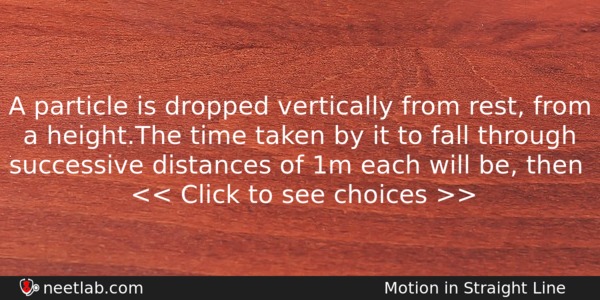| ⇦ | 
| ⇨ |
A particle is dropped vertically from rest, from a height.The time taken by it to fall through successive distances of 1m each will be, then
Options
(a) all equal, being equal to √2/g sec
(b) in the ratio of the squareroots of the integers 1, 2,3,…
(c) in the ratio of the diffrence in the square roots of the integers, i.e.√1 ,(√2 – √1), (√3 – √2) ,(√4 – √3)….
(d) in the ratio oif the reciprocals of the square roots of the integers, i.e. 1 / √1, 1 /√2, 1 / √3, 1 / √4
Correct Answer:
in the ratio of the diffrence in the square roots of the integers, i.e.√1 ,(√2 – √1), (√3 – √2) ,(√4 – √3)….
Explanation:
No explanation available. Be the first to write the explanation for this question by commenting below.
Related Questions: - When the wave of hydrogen atom comes from infinity into the first orbit,
- When a ceiling fan is switched off its angular velocity reduces to 50% while
- A particle of mass m oscillates along x-axis according to equation x = a sin ?t
- The equiconvex lens has focal length f. If it is cut perpendicular to the principal
- The threshold wavelength for photoelectric emission from a material is 4800 Å.
Topics: Motion in Straight Line
(93)
Subject: Physics
(2479)
Important MCQs Based on Medical Entrance Examinations To Improve Your NEET Score
- When the wave of hydrogen atom comes from infinity into the first orbit,
- When a ceiling fan is switched off its angular velocity reduces to 50% while
- A particle of mass m oscillates along x-axis according to equation x = a sin ?t
- The equiconvex lens has focal length f. If it is cut perpendicular to the principal
- The threshold wavelength for photoelectric emission from a material is 4800 Å.
Topics: Motion in Straight Line (93)
Subject: Physics (2479)
Important MCQs Based on Medical Entrance Examinations To Improve Your NEET Score
18000+ students are using NEETLab to improve their score. What about you?
Solve Previous Year MCQs, Mock Tests, Topicwise Practice Tests, Identify Weak Topics, Formula Flash cards and much more is available in NEETLab Android App to improve your NEET score.
Share this page with your friends

Leave a Reply